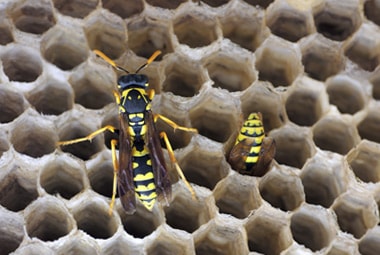
The paper wasp is a very common pest and is found throughout the state of Missouri. They get their name from the paper-like material that they use to create their umbrella-shaped nests.
| Pest Identification | |
|---|---|
| Recognition | Adult paper wasps grow to be ½ to 1 inch in length. They are black or brown with yellowish markings; their wings are grayish in color. Paper wasps have a narrow body and pinched waist. Their legs hang in a distinctive manner below their body as they fly. |
| Biology | The life-cycle of the paper wasp begins each spring, usually in April, when the overwintering females are fertilized and emerge to build a nest. First, they will lay their group of eggs. Once larvae hatch and develop into female workers, these workers help to take care of the single queen. These workers also care for the eggs and larvae, forage for food, and increase the size of the colony. In the late summer, the existing queen will start producing males and new queens, the males die off after mating and the newly fertilized queens will overwinter, usually behind the bark of trees, until the next spring when they will emerge to start the reproductive cycle over again. Paper wasps have a stinger but are not a particularly aggressive species of stinging insect; they will, however, sting in order to defend themselves or their colony. The venom from a paper wasp sting can cause a severe allergic reaction in some people that requires immediate medical attention to prevent serious consequences. |
| Habits | Paper wasps are an environmentally beneficial species of insect; they feed on nectar and pollen and are responsible for pollinating a variety of crops and plants. They also prey on a number of insects that they feed to the developing larvae in their colony which helps to control nuisance insects. Paper wasps chew on wood and mix it with their saliva in order to create the paper-like material that they make their nests from. Their distinctive nests are tan and are made from individual honeycomb-shaped cells that are placed next to each other. They place their nest up off the ground and will hang them from trees, shrubs, porches, roof soffits, decks, and door frames. |
| Prevention | Preventing stinging insects like paper wasps from choosing your property to nest on is a tough task, but there are some things that you can do to help stop them from creating their nest near, on, or in your home. Make sure to trim back trees and shrubs from the exterior of your house, and place tight-fitting caps on all chimneys. Fix loose roof shingles, repair holes along roof lines, and check to be sure that you have intact screens in all windows and doors. |
| Professional | The first step in controlling paper wasp populations is by identifying problem areas on your property. Paper wasps can be very protective of their nests and this should be handled by a trained professional. At Rottler our technicians are continually trained and have the education and experience to safely identify areas through their inspection process. Once problem areas are targeted our technician will liberally inject residual insecticide dust into the nest entrance. For structural nests, the cavity will be treated with a dust or aerosol formulation, but the entrance will not be sealed until the colony has been destroyed. Treated structural nests will be removed, if accessible. |

